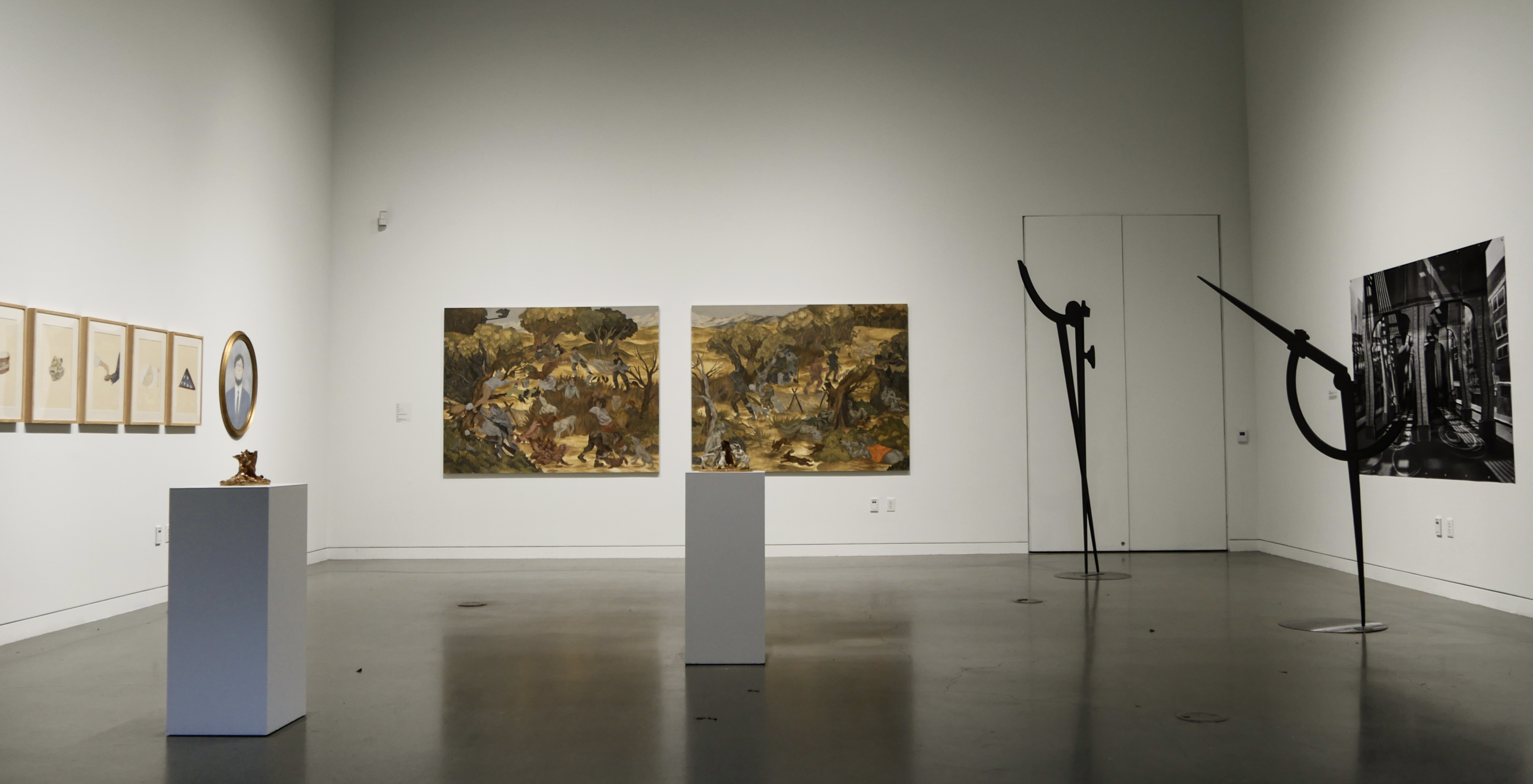In “Cardinal Canvas,” Adam Golomb spotlights art on and around the University, exploring and reviewing artwork that students may otherwise miss.
Editor’s Note: This article is a review and contains subjective opinions, thoughts and critiques.
Five first-year MFA students re-contextualized and reshaped history in their showcase “&,” curated by Associate Photography Professor Jonathan Calm. The showcase’s artwork — which will be on display at the Coulter Art Gallery until March 15 — engages in conversation about identity and community, introducing five unique perspectives that critique the world around them.
In her painting “Rabitting,” Emily Harter creates a scene of hunting season with warm colors and a sense of pursuit. Grey-colored hunters run rampant with rifles, some hiding in bushes to find just the right angle and some helplessly scratching their heads. The titular rabbits scurry, avoidant of their predators’ reach, despite the overwhelming army of hunters and dogs.
“Rabbiting” portrays community from two standpoints. First is the huntsmen’s, all working together towards a common goal. Contrasted by the bright golden grass, the grayscale hunters blend into one another: one battalion indivisible. Their unity is moving, yet moored by bloodshed of innocent creatures. Harter asks the audience: “What does it mean to revel at the fall of others?”
Her own answer might be revealed through the rabbits themselves. I question whether the rabbits feel the anxiety of potential abduction; they run in circles, almost teasing the hunters, but also jump high and fast, as if running from doom. To be hunted is a paradox of utter fear and carelessness — it is shackling and liberating alike.
Elina Frumerman explores the metaphorical barriers to entering a community in her three-piece work “The Distance Between,” an acrylic painting depicting an early memory of immigrating to the US from the USSR. Her memory captures a black-and-white image of an endlessly long metallic station decorated with tall, metal, compass-like sculptures; the artwork also includes two of those steel sculptures reconstructed in real life, guarding the painting.
Frumerman contrasts the tangible from the intangible in memories. While the painting’s realism convinces the audience of this station’s existence, the materiality of the sculptures undercuts that image, putting the memory’s reality into question. It is impossible to not compare the abstraction of that memory to the visible shadow of the sculptures.
In this way, “The Distance Between” simulates the supposed rules and boundaries of arriving to a novel land. People are asked to leave memories of their past, of a previous life, at the door, becoming abstract concepts that can’t match the real – or, at least, their new reality.
Another artist, Damon Casarez, further questions the rules of immigration in his work “Attributes of a Good Citizen.” The piece is comprised of five paintings: a tuna sandwich, a crumpled dollar, a white hand above a darker-skinned one reminiscent of Michaelangelo’s “The Creation of Adam,” an unfilled burrito and a folded American flag.
Casarez’s paintings reflect the cultural assimilation expected of immigrants. Acting as a guidebook, “Attributes” walks an outsider through Anglo-American values of money, work and patriotism. Previous cultural heritage acts as baggage to be discarded before assuming a new identity, one of assimilated tuna sandwiches and empty burritos.
In the third painting, however, Casarez illustrates the only way to maintain one’s cultural identity: to be the hand receiving. The top hand grandly bestows something indiscernible to the darker hand beneath it. This piece exposes the systematic efforts to force immigrants to perceive their culture as inferior, as requiring donation.
Other artists illustrated community by elevating individual relationships. In “Remember When, Remember When…,” Cooper Salmon immortalizes small interpersonal moments through a series of colorful pastel paintings. A son playing a violin stubbornly while his mother watches over; a dentist carefully peering into a patient’s mouth; a kid spraying water into an older man’s mouth.
Salmon implements a cartoonish style to prioritize genuine emotion over direct likeness. In a scene of newlyweds, my personal favorite, the groom’s big blue eyes are filled with tears of joy as his cartoonishly large hand holds his bride’s hand. The work urges us to value the sentiment of our interactions rather than their materiality.
Salmon’s pastel colors and comic visuals also depict his literal vision. The artist is diagnosed with Retinitis Pigmentosa, an eye disease that will eventually leave him blind. As a result, his cataracts led to both looseness and sharpness in color, which he manifests in his work: a beautiful and tragic love letter to the world and how he perceives it.
The final piece challenges cultural symbols and the morality bestowed upon them. “Untitled (Mary)” by Andrew Sungtaek Ingersoll is a sculpture of the Virgin Mary made out of ground meat discards from grocery stores. The statue inhabits a commercial freezer, cryogenically formed with red pigment to maintain its color.
When I read about the material of this piece, I was shocked. A holy figure made out of frozen, trashed, bloody meat; it is the definition of sacrilegious. Ingersoll provocatively presents a deity as, quite literally, garbage, calling into question how we perceive cultural and religious icons. What does it mean to worship the undesired insides of an animal? The piece encourages us to critique what we may be blindly complicit to, to re-examine what we value, lest it also be composed of rotting meat.
This showcase is a thought-provoking delight, providing insight into what it means to belong to a community from various angles. I strongly encourage anyone to go see it.
